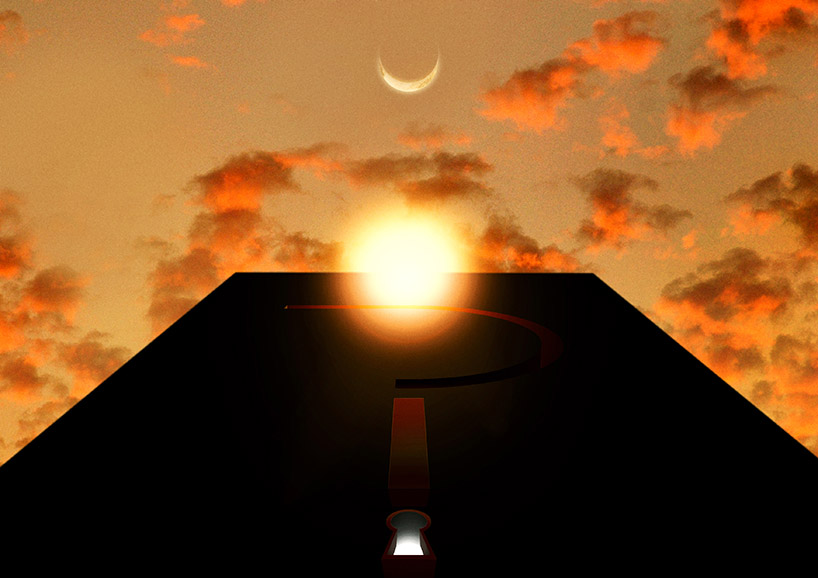
Curiosity Gate by Rute Peixoto from portugal
designer's own words:
Curiosity Gate
Curiosity can be described and felt in various ways. It is often the driving force that sets you on a path, inquiring, looking for answers. Sometimes, the motivation is as bold as the question “Were there ever favorable conditions for life in Mars?”, or just a simple one like “what lies beyond that door?”, Other times, there is not even a formalized riddle in your head, just a feeling in your gut - a doubt kindled by something that immediately grabs your attention.
Our design was kick-started precisely by this universal and simpler kind of curiosity – the kind that would appeal to any person. This premise made us wonder what moment or circumstance would really embody what is generically called “curiosity” and an act driven by it.
We finally decided that “context” and “contrast” would be key concepts for our design. It became clear for us that something out of its original context will always stand out, and if subtly placed it can make people draw nearer, conveying a feeling of mystery and, of course, curiosity. Kubrick masterfully portraits this primordial effect of curiosity – opposed by fear – in the prelude of 2001: Space Odyssey, with the black monolith.
The very same level of curiosity can be read in the act of looking through a keyhole. It’s only natural to feel slightly curious about what you would see if you were to peek through the keyhole of a closed door. The appropriate question here is quite obvious, even if it isn’t clearly formed in your mind. “Why is it shut?”.
Children, being free of the prejudice regarding this act, are usually not familiarized with the privacy norms. They often allow themselves to be driven by this sort of curiosity. The honesty that characterizes such a moment really attracted us. We wanted to use this in a way that would make people forget it’s wrong to try to see what a closed door hides, and to invite them to look through a keyhole.
Since doors are most commonly seen as public/private intermediates, we chose to use this to our advantage. Basically, if we were to place a door in a public square, would people refrain themselves from looking through its keyhole? We ended up deciding to do so, making it also really hard not to be intrigued by this curious “door”.
The main objective of the door we designed thus became drawing people near, gently suggesting them to look through the keyhole. Its design and the way it is placed in space both contribute to this sense of mystery that would eventually awaken the feeling of curiosity in anyone who would pass by.
In its main side there is a question mark composed of a hollow curve, a straight vertical door handle, and a big keyhole which pops out, inviting everyone to peer through. And since the installation is in fact a free standing door in public space, it is not a closed openable barrier that prevents outsiders from passing. We actually nullified the threshold so that the purpose of the door would cease to be its common usage, thus becoming something else entirely. A strange object oddly placed out of context.
And then we asked ourselves the following question: If you could peek at what is happening on the other side of the world, right now, would you? If only you had the power to do so? Nowadays, most people go about their lives day by day often becoming prisoners of their own schedules. When they get home, they sit facing their computer screens and initiate their internet routines.
What if somehow people were linked in a new kind of way, sharing their own routines in their own cities with the world? Considering this, we chose to use the door as a visual connection between public places spread across the surface of our planet. In fact, our design is only complete if there are at least two “doors” linking two different public places, two distinct contexts.
On the opposite face of the side which shows the question mark, the door is covered with a mirror that negates its materiality, representing the concept that the door is sectioned: its second physical half is any other of the doors that are spread around the world. It’s like a dimensional rip - unlike a common door in which the keyhole consists in two ends of the same hole for a key, this special door has a keyhole which has only one end. The other end belongs to another door in a different place – and thus all the doors installed are connected, since they all share their keyholes.
So looking through any of these doors’ keyholes would show you a different place as if, for example, Paris and Tokyo (if two doors would be installed in a public place of each of these cities) were separated by a mere door, and not by thousands of kilometers.
In order to achieve this, we propose that each of these doors is to be equipped inside with a system that can record and livestream. The screen that shows the livestream is visible only by looking into the keyhole. Hidden in the curve of the question mark of all these doors there is a camera that records whichever scene each door faces. The livestream process is made possible by a wired or wireless hotspot connection.
The effect is simple but intense: looking through one keyhole will show you a live recording of whatever is happening in front of the camera installed in any of the other doors. If you turn the handle, the screen will show you a different livestream of a different place. The system would be programmed so that the place you would be observing would not be able to show a recording of the place you were in, and you would not be able to see a livestream of the place in which people were peering at you.
Our goal with this is to connect people, in a playful way that interrupts, even if only for some happy moments, their daily routines. We want people to feel curious about what is happening in others cities, and to break visually the boundaries between countries. Only your vision passes through these doors and although they are closed, they are an unexpected gate for your imagination providing you have the curiosity it takes to look into a keyhole!
Curiosity Gate0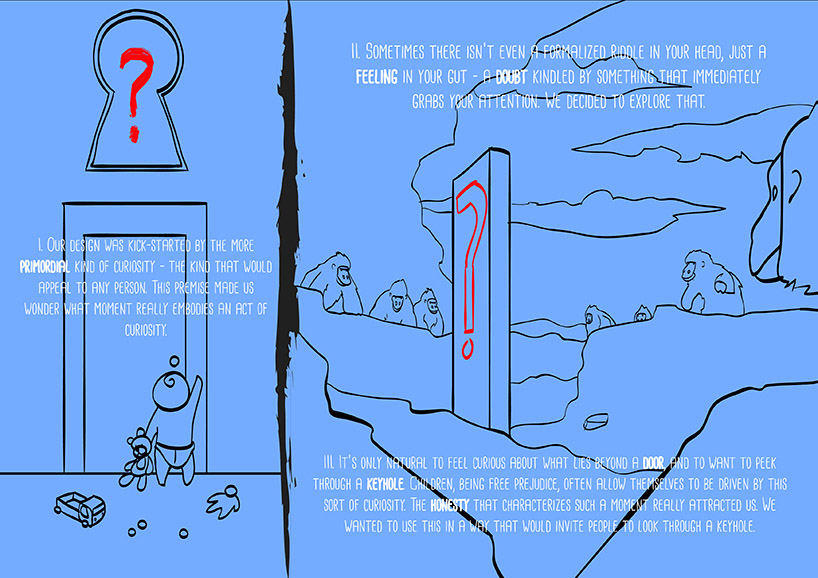
Curiosity Gate1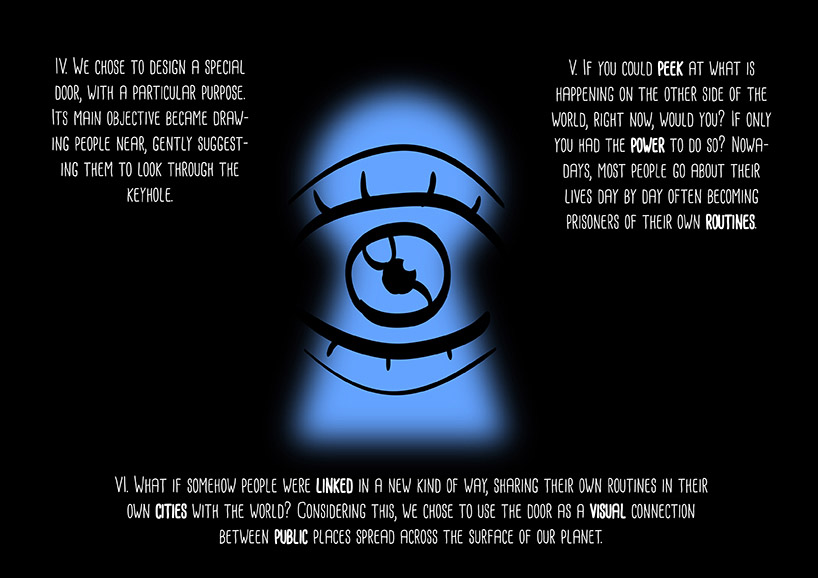
Curiosity Gate2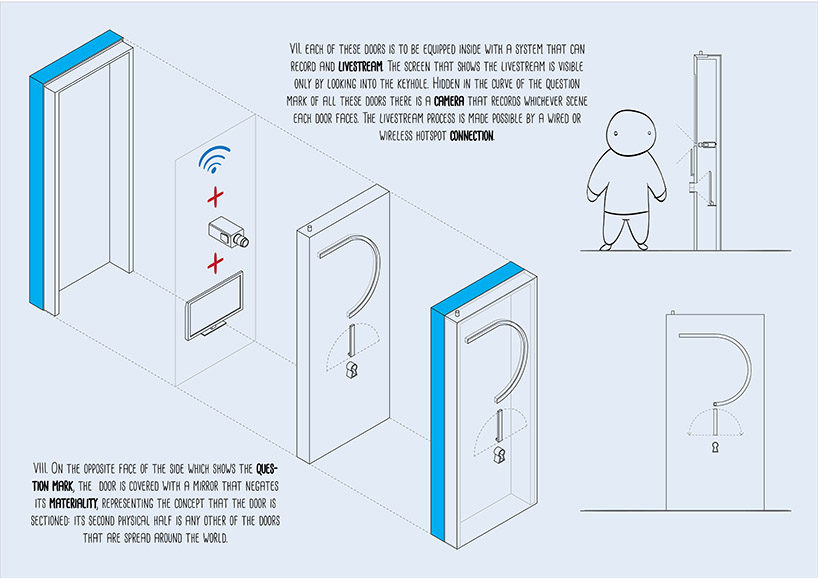
Curiosity Gate3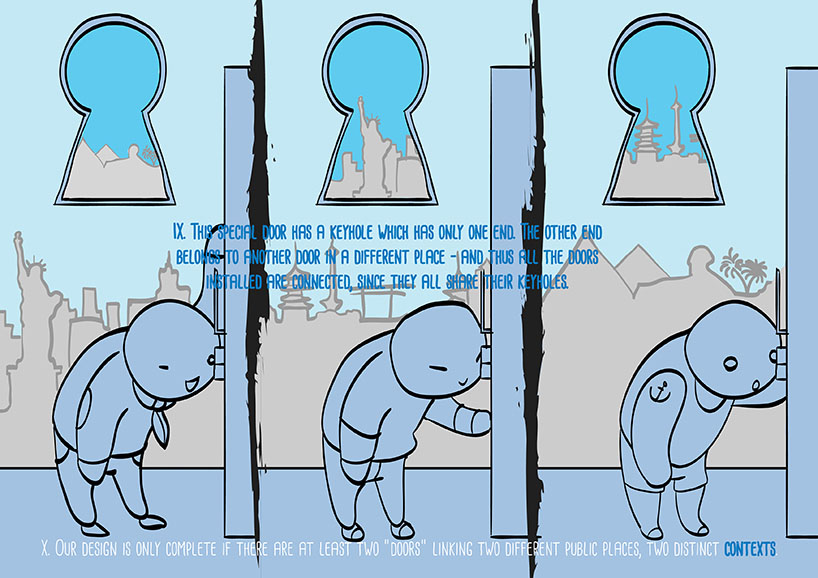
Curiosity Gate4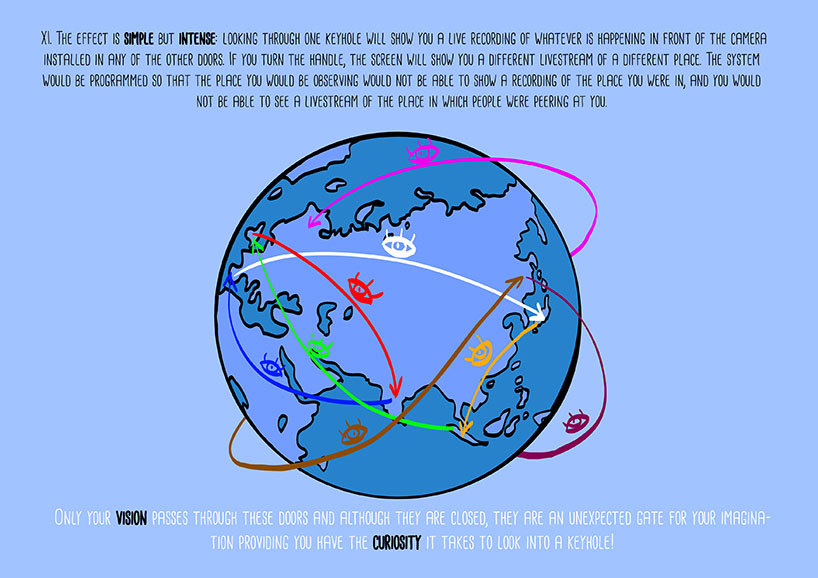
Curiosity Gate5